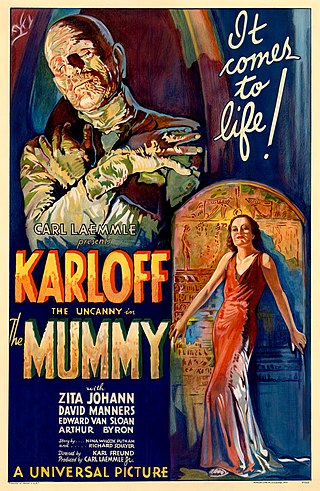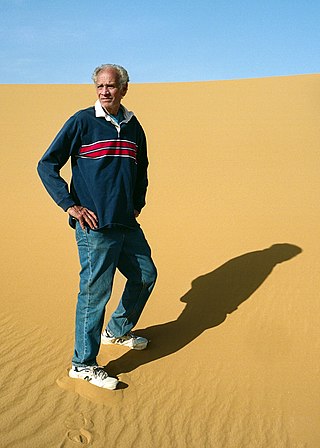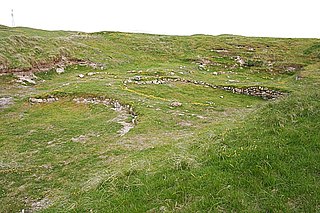Related Research Articles

A mummy is a dead human or an animal whose soft tissues and organs have been preserved by either intentional or accidental exposure to chemicals, extreme cold, very low humidity, or lack of air, so that the recovered body does not decay further if kept in cool and dry conditions. Some authorities restrict the use of the term to bodies deliberately embalmed with chemicals, but the use of the word to cover accidentally desiccated bodies goes back to at least the early 17th century.

Tutankhamun, Tutankhamon or Tutankhamen, also known as Tutankhaten, was the antepenultimate pharaoh of the Eighteenth Dynasty of ancient Egypt. His death marked the cessation of the dynasty's royal line.

Egyptology is the scientific study of ancient Egypt. The topics studied include ancient Egyptian history, language, literature, religion, architecture and art from the 5th millennium BC until the end of its native religious practices in the 4th century AD.

Saqqara, also spelled Sakkara or Saccara in English, is an Egyptian village in the markaz (county) of Badrashin in the Giza Governorate, that contains ancient burial grounds of Egyptian royalty, serving as the necropolis for the ancient Egyptian capital, Memphis. Saqqara contains numerous pyramids, including the Pyramid of Djoser, sometimes referred to as the Step Tomb, and a number of mastaba tombs. Located some 30 km (19 mi) south of modern-day Cairo, Saqqara covers an area of around 7 by 1.5 km.

The Mummy is a 1932 American pre-Code supernatural horror film directed by Karl Freund. The screenplay by John L. Balderston was adapted from a treatment written by Nina Wilcox Putnam and Richard Schayer. Released by Universal Studios as a part of the Universal Classic Monsters franchise, the film stars Boris Karloff, Zita Johann, David Manners, Edward Van Sloan and Arthur Byron.

Robert Brier is an American Egyptologist specializing in paleopathology. A senior research fellow at Long Island University/LIU Post, he has researched and published on mummies and the mummification process and has appeared in many Discovery Civilization, TLC Network, and National Geographic documentaries, primarily on ancient Egypt.

Cladh Hallan is an archaeological site on the island of South Uist in the Outer Hebrides in Scotland. It is significant as the only place in Great Britain where prehistoric mummies have been found. Excavations were carried out there between 1988 and 2002, which indicate the site was occupied from 2000 BC.

The ancient Egyptians had an elaborate set of funerary practices that they believed were necessary to ensure their immortality after death. These rituals included mummifying the body, casting magic spells, and burials with specific grave goods thought to be needed in the afterlife.

Tomb KV60 is an ancient Egyptian tomb in the Valley of the Kings, Egypt. It was discovered by Howard Carter in 1903, and re-excavated by Donald P. Ryan in 1989. It is one of the more perplexing tombs of the Theban Necropolis, due to the uncertainty over the identity of one female mummy found there (KV60A). She is identified by some, such as Egyptologist Elizabeth Thomas, to be that of the Eighteenth Dynasty pharaoh Hatshepsut; this identification is advocated for by Zahi Hawass.
In ancient Egypt, cats were represented in social and religious scenes dating as early as 1980 BC. Several ancient Egyptian deities were depicted and sculptured with cat-like heads such as Mafdet, Bastet and Sekhmet, representing justice, fertility, and power, respectively. The deity Mut was also depicted as a cat and in the company of a cat.

The Chinchorro mummies are mummified remains of individuals from the South American Chinchorro culture, found in what is now northern Chile. They are the oldest examples of artificially mummified human remains, having been buried up to two thousand years before the Egyptian mummies. The earliest mummy that has been found in Egypt dated around 3000 BCE, while the oldest anthropogenically modified Chinchorro mummy dates from around 5050 BCE.
Joann Fletcher is an Egyptologist and an honorary visiting professor in the department of archaeology at the University of York. She has published a number of books and academic articles, including several on Cleopatra, and made numerous television and radio appearances. In 2003, she controversially claimed to have identified the mummy of Queen Nefertiti.

Museo de la Naturaleza y Arqueología (MUNA), is a museum-based in Santa Cruz de Tenerife, Tenerife,. It contains many significant archaeological finds and is considered the best repository of objects from the Pre-Castilian Canary Islands. The museum also houses significant paleontological, botanical, entomological, and marine and terrestrial vertebrate collections, and is considered the best Natural Library of the Canary Islands.

Animal mummification was common in ancient Egypt. Animals were an important part of Egyptian culture, not only in their role as food and pets, but also for religious reasons. Many different types of animals were mummified, typically for four main purposes: to allow people's beloved pets to go on to the afterlife, to provide food in the afterlife, to act as offerings to a particular god, and because some were seen as physical manifestations of specific deities that the Egyptians worshipped. Bastet, the cat goddess, is an example of one such deity. In 1888, an Egyptian farmer digging in the sand near Istabl Antar discovered a mass grave of felines, ancient cats that were mummified and buried in pits at great numbers.

The Younger Lady is the informal name given to an ancient Egyptian mummy discovered within tomb KV35 in the Valley of the Kings by archaeologist Victor Loret in 1898. The mummy also has been given the designation KV35YL and 61072, and currently resides in the Egyptian Museum in Cairo. Through recent DNA tests, this mummy has been identified as the mother of the pharaoh Tutankhamun and a daughter of pharaoh Amenhotep III and his Great Royal Wife Tiye. Early speculation that this mummy was the remains of Nefertiti was argued to be incorrect, as nowhere is Nefertiti accorded the title "King's daughter."

Usermontu is an ancient Egyptian mummy exhibited at the Rosicrucian Egyptian Museum in San Jose, California.
Ann Rosalie David is a British Egyptologist and emeritus professor at the University of Manchester. David served as director of the International Mummy Database.

Sha-Amun-en-su was an Egyptian priestess and singer who lived in Thebes during the first half of the 8th century B.C., responsible for ceremonial duties at the Temple of Karnak, dedicated to the god Amun. Sha-Amun-en-su was a Heset, i.e., a member of the foremost group of singers with ritualistic functions active in the temple of Amun. After her death, which is estimated to have occurred around the age of 50, the singer was mummified and placed in a sarcophagus made of stucco and polychrome wood. Since its sealing, more than 2700 years ago, Sha-Amun-en-su's sarcophagus had never been opened, throughout its history, conserving inside the singer's mummy, a feature that gave it extreme rarity.
The archaeology of Ancient Egypt is the study of the archaeology of Egypt, stretching from prehistory through three millennia of documented history. Egyptian archaeology is one of the branches of Egyptology.
References
- ↑ "Calling Dr Jones". This Week At Macquarie University. 14 September 2015. Retrieved 5 February 2024.
- ↑ Jones, Jana (28 September 2018). "Prehistoric Egyptians mummified bodies 1,500 years before the pharaohs". CNN. Retrieved 5 February 2024.
- ↑ Wei-Haas, Maya (15 August 2018). "Mummy Helps Confirm Earliest Egyptian Embalming Recipe". National Geographic. Retrieved 5 February 2024.
- ↑ Masterson, Andrew (15 August 2018). "Egyptian mummification pushed back 1500 years". cosmosmagazine.com. Retrieved 5 February 2024.